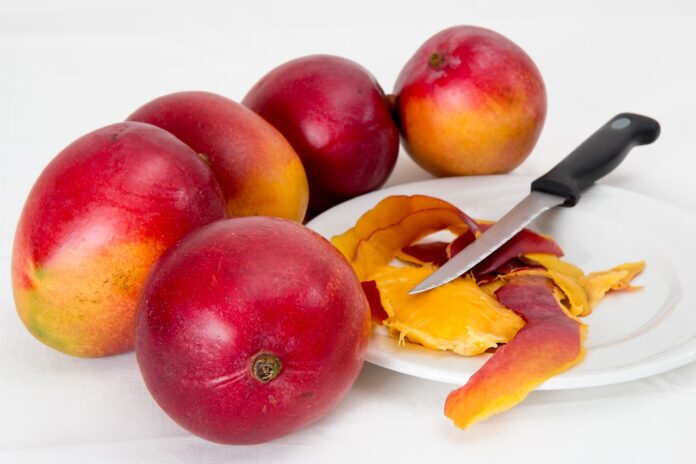According to legend, the luxurious exotic plant with fleshy fruits of reddish or orange color appeared in India almost 8,000 years ago. It was planted on earth by the god Shiva for his beloved. Mango translates from Sanskrit as “great fruit,” and this name fully justifies itself.
Evergreen trees of the sumac family are cultivated as fruit and ornamental crops, and they are also common in the wild. There are more than 2,000 known species of mango.
Interesting facts about mango:
- In Pakistan and India, the tree is considered sacred. Its leaves are scattered at weddings to ensure that the young couple lives happily ever after.
- Hindus believe that mangoes fulfill secret desires.
- Fruits are hung above the entrance to homes on New Year’s Eve to seek support from higher powers and attract prosperity.
- Asian nobles owned large mango orchards, emphasizing their high social status.
There is an ancient tradition of giving ripe aromatic fruits to relatives and friends during holidays, wishing them prosperity. - The closest “relatives” of Mangifera indica are Jamaican plum, pistachios, cashews, and the poisonous shrub sumac.
- In medicine, mango fruits, as well as the bark, leaves, and seeds of the mango tree, are used.
- The peel of an unripe fruit contains toxic substances that can cause allergies.
- It is not recommended to overconsume mangoes. Eating three or more at once can cause digestive issues.
- The largest fruit on record was grown in Hawaii: it weighed 3.5 kg and was 30 cm long.
- The harvest from wild trees is inedible, as the smell and taste of the fruits resemble turpentine.
Where does mango grow?
The homeland of the mango is considered to be the Indian state of Assam and Myanmar. Mango trees are cultivated in the Solomon Islands, the Philippines, Pakistan, California (USA), Cuba, Bali, Australia, the western part of Malaysia, southern provinces of China, Thailand, Spain, and the Canary Islands. The climate in these places is ideal for mangoes: hot, with little rainfall.
The richest harvest is collected in India, which is considered the largest supplier, accounting for 40% of the world market. China follows, where extensive mango plantations appeared in the 1960s. The third-largest exporter is Thailand.
The fruit is also popular in Indonesia, Egypt, Vietnam, and other countries. Decorative trees also successfully bear fruit in Russia (Krasnodar Krai).
Mango – a tropical fruit giant
Trees with large fluffy crowns of rounded shape impress with their beauty, especially during the flowering period (from February to March). 20-meter giants are covered with yellowish, red, or pink panicles. Each has hundreds of small buds up to 7 mm in size, with the majority being male, and only about 10% being bisexual. One panicle produces only a couple of ovaries. Pollinators are bats and insects.
Flowering mango plants are literally enveloped in a persistent sweet scent reminiscent of lilies. That’s why mangoes are often used in landscape design; these magnificent plants look wonderful not only in a personal garden but also in parks or squares.
Some mango tree specimens can live up to 300 years while continuing to bear fruit.
To sustain its gigantic crown and provide it with nutrients, the tree forms a branched root system that extends up to 9 meters deep.
In natural conditions, at comfortable temperatures and moderate humidity levels, evergreen mangoes can grow over 30 meters tall, with a crown diameter of 8 meters and lanceolate leaves up to 40 cm long. Wild trees bear fruit once a year, while agricultural varieties do so twice.
Dwarf mangoes are planted on plantations because they are easier to care for. Low-growing plants are cultivated in greenhouses, conservatories, and hothouses.
Propagation methods for the culture include:
- by seeds;
- vegetatively;
- by grafting.
The beneficial properties of mango for both women and men are undeniable. Since ancient times in India, the fruit has been considered a source of vitality and health. Its composition is a powerful “cocktail” of essential ingredients, including B-group vitamins, vitamins A, C, D, as well as zinc, iron, manganese, and phosphorus.
- Beta-carotene, found in the pulp, has a beneficial effect on mucous membranes and improves vision.
- In diabetes, mangoes are included in the diet of patients with non-insulin-dependent type 2 diabetes. Mangiferin reduces blood sugar levels and is also an excellent aid in weight loss.
- The exotic fruit mango is an excellent analgesic, used as an antipyretic and for the prevention of malignant tumors that form in the pelvic organs. Mango is recommended for consumption in cases of urinary and reproductive system disorders. Pregnant women who enjoy tasty exotic fruits do not suffer from swelling.
- Magnesium and potassium have a relaxing effect on the nervous system, relieving depressive states and normalizing blood pressure.
- Mango is beneficial for the skin. With its anti-aging effect, the aromatic fruits tone and rejuvenate it. Vitamin A eliminates acne, pigmentation spots, and acne.
- Vitamin C strengthens the hair by stimulating collagen production. Strands become luxurious and shiny. Thanks to its rich vitamin E content, this tropical delicacy promotes hair growth and prevents the appearance of gray hair.
- Mango is indispensable for men, as the complex of beneficial substances is the best prevention for men’s health problems.
- People with anemia can replenish their iron deficiency by regularly consuming mangoes. The presence of calcium and vitamin K makes it a natural remedy for patients suffering from musculoskeletal disorders. Lupeol relieves pain and stops inflammatory processes in arthritis.
- Mango boosts the immune system, alleviates allergy symptoms, and fights infections.
- One medium-sized fruit compensates for almost half of the body’s daily fiber needs, ensuring the stable functioning of the digestive system.
